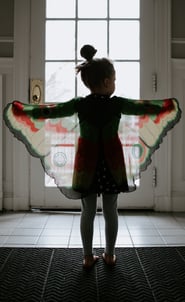I'll be the teacher. You be Peter, the student,
or
I'll be the fireman. You be the lady in the house on fire.
If you're like most adults, you'll remember similar conversations from your childhood. Maybe you were sitting on the stoop of your tenement building, or maybe you were in your leafy backyard in the suburbs. That may be how it appeared to the world at large, but in your imagination, you were far, far away.
The Importance of Imagination in Everyday Play
You may remember the fun you were having creating whatever scenario fit the picture in your mind. What you didn't realize at the time was that you were exploring roles, working out what you would do in situations that disturbed you, or perhaps rearranging reality as you hoped it could be. But then the real world called you back.
The truth is, once that moment you spent immersed in your imagination passed, you were never exactly the same. You had grown into a more creative, more cooperative person with a better understanding of what it means to be. Period, end of sentence - to be! That after all is the point of creative play. There's no end goal set for creative play. It just is. This is why it's so important that you not fill every moment of your child's day with "meaningful" activities. Instead, ponder the question the 2-ton elephant in the room is asking. Who finds the meaning in adult-designed play? The adult or the child?
The Changing Role of Imagination in Child Development
The meaning of 'meaningful' changes as a child matures and enters a new stage of creative play. Although each child is miraculously unique and will of course differ from his or her siblings, there are five stages of imaginative play that children grow into and out of.
14 - 18 months: Imaginative play mirrors everyday solo life with pretend activities limited to self-centered experience. Usually involves a doll or stuffed animal whom they may see as a baby; in other words, a stand-in for themselves.
limited to self-centered experience. Usually involves a doll or stuffed animal whom they may see as a baby; in other words, a stand-in for themselves.
19 months - 22 months: Imaginative play extends to recreating common activities involving interaction with another - the child may use a spoon to feed a teddy bear or a cloth to wash a doll's face
2 years to 3 years: Imaginative play still conforms to the child's home experiences, but the ability to verbally plan enters into what has progressed to multi-step play. When engaged in this stage of imaginative play, the child considers it important that the activity doesn't stray from the order he has planned. For example, in addition to feeding a doll with a spoon as cited above, he may begin by washing its hands, add giving it a sip of water, and end by wiping its face with a napkin.
3 1/2 - 4: Imaginative play is based on activities the child has experienced but in which she never played an active role. She will also start to use her imagination to substitute items or places for those she doesn't have access to. For example, she may fill a box with stuffed animals and then push it under the dining room table, re-enacting her parent driving her and her siblings into the garage.
5 - 6: While imaginative play activities may have been solitary up to now, even if other children were present, they all engaged in separate but parallel play. Now he needs others to fill the roles he imagines. He makes use of gestures and various tones of speech to infer emotion in his role-playing. Likewise, he will expect his playmates to answer in kind.
The Added Importance of Settings that Support Imagination Today
Children at this stage will want to play in settings away from their immediate homes. This is especially important for those who spent the all-important preceding developmental stages in pandemic isolation with only their families for companions. And while they may be happy to play on their block or in a neighbor's yard, the ideal place for imagination to run free is in a park or schoolyard rich with enticing structures designed to stimulate their creativity and invite open-ended play.
